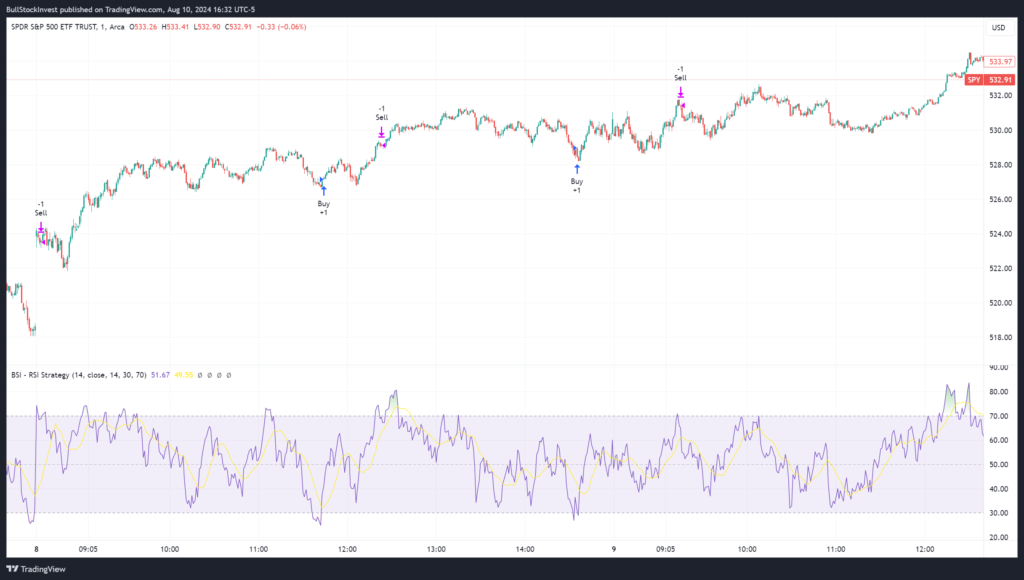The Relative Strength Index (RSI) is a popular momentum oscillator used in technical analysis to measure the speed and change of price movements. Developed by J. Welles Wilder Jr. in 1978, the RSI is a vital tool for traders aiming to identify potential buy or sell signals, overbought or oversold conditions, and market trends.
Relative Strength Index (RSI) Description
The RSI is a momentum indicator that ranges from 0 to 100. It helps traders determine whether an asset is overbought or oversold, indicating potential reversal points or continuation of trends. RSI values above 70 suggest an asset is overbought, while values below 30 indicate it is oversold. The RSI is typically used over a 14-period timeframe, which can be adjusted to suit different trading strategies.

Relative Strength Index (RSI) Formula
The RSI is calculated using the following formula:

Where RS (Relative Strength) is the average gain of up periods during the specified time frame divided by the average loss of down periods over the same time frame.
Market Type: Range-Bound vs. Trending
In a range-bound market, the RSI is particularly effective for identifying overbought and oversold conditions. In contrast, during a trending market, traders use the RSI to confirm the strength of the trend or spot potential reversals.
Overbought
When the Relative Strength Index (RSI) value is above 70, the asset is considered overbought, indicating that it may be due for a price correction or pullback. Traders might consider selling or shorting the asset at this point, especially if other technical indicators confirm the signal.
Oversold
Conversely, when the Relative Strength Index (RSI) falls below 30, the asset is deemed oversold, suggesting that it might be undervalued and due for a price increase. Traders often look for buying opportunities when the RSI signals oversold conditions.
Entry
Traders can use the Relative Strength Index (RSI) to enter trades by looking for signals that an asset is either overbought or oversold. A common strategy is to enter a long position when the RSI crosses above 30 or enter a short position when it crosses below 70.
Exit
Exiting a trade using Relative Strength Index (RSI) involves looking for opposite signals to the entry point. For instance, if a trader entered a long position when the RSI was below 30, they might consider exiting when the RSI approaches or exceeds 70, signaling overbought conditions.
Divergence
Divergence occurs when the price of an asset and the Relative Strength Index (RSI) move in opposite directions. Bullish divergence is observed when prices make new lows while the RSI makes higher lows, indicating a potential upward reversal. Conversely, bearish divergence occurs when prices make new highs, but the RSI makes lower highs, signaling a potential downward reversal.
Relative Strength Index (RSI) Backtesting
Backtesting the RSI involves applying it to historical data to evaluate its effectiveness. Traders can backtest using various timeframes, such as 1-minute or 1-day charts, to determine which setting best suits their trading style. Typical settings involve a 14-period RSI, but traders may experiment with shorter or longer periods to optimize results.
| Time Interval | 1 minute | 1 day |
| Indicator Settings | RSI Length: 14 days Source: Close Price | RSI Length: 14 days Source: Close Price |
| Percent Profitable | 60.53% | 84.00% |
| Profit Factor | 1.02 | 2.974 |
| Sharpe Ratio | −18.159 | −275.052 |
| Sortino Ratio | −0.998 | −1 |
The Relative Strength Index (RSI) is a versatile and valuable tool in technical analysis, helping traders identify potential entry and exit points while providing insights into market trends and reversals. By combining RSI with other technical indicators, traders can enhance their strategies and improve their decision-making processes.




